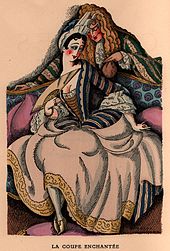Gerda Wegener
Gerda Wegener (born March 15, 1886 in Hammelev , † July 28, 1940 in Frederiksberg ) was a Danish illustrator and painter of Art Nouveau and Art Deco .
Life
Gerda Marie Frederikke Gottlieb grew up as the daughter of a country clergyman Huguenot origin in the then politically to the German Reich belonging Nordschleswig . She went to Copenhagen to study at the Royal Danish Academy of Fine Arts . There she met the artist Einar Wegener, who later called himself Lili Elbe and whom she married in 1904. In order to expand her sphere of activity and to be able to live out her lesbian orientation more freely, she moved with her husband to Paris in 1912 , where she worked as a painter and illustrator for magazines such as Vogue , La Vie Parisienne , Fantasio, Le Rire, La Baïonnette and many others . Her success enabled her to exhibit regularly in the Ole Haslund Gallery in Copenhagen . Her career was based on talent and diligence, but not least on the sensation that her unusual marriage caused.
Einar Wegener, who was initially considered the larger of the two artists, put his own work on hold in order to support his wife in her endeavors. He posed for Gerda Wegener in women's clothes, called himself Lili Elbe from then on, and became Gerda's preferred model. In 1930 Lili underwent gender reassignment surgery , which was one of the first of its kind to cause a tremendous sensation and made Lili Elbe famous. Gerda Wegener supported her intersex partner to the best of her ability during the transition period. In 1930 their marriage was annulled by the Danish king.
In 1931 Gerda Wegener married the eleven years younger Italian officer, pilot and diplomat Major Fernando Porta, with whom she moved to Marrakech and then to Casablanca . There in Morocco she found out that Lili Elbe had died in the Dresden women's clinic after a uterus transplant by Kurt Warnekros . In 1936 Gerda Wegener divorced Fernando Porta and returned to Copenhagen. She had her last exhibition in 1939, but her style had gone out of style. She died of a heart attack a few months after the occupation of Denmark by the Wehrmacht of the German Reich.
Aftermath
The Second World War put an abrupt end to the luxury era of Art Deco . It was only social trends such as sexual liberation , feminism and the gender debate that stimulated interest, especially in Gerda Wegener's erotic works. Today her work, like that of George Barbier and Erté , fetch high prices at auctions.
reception
David Ebershoff's novel The Danish Girl (original title The Danish Girl ) from 2000 deals with the life story of Lili Elbe and Gerda Wegener (in the book as American painter Greta Waud). The book was an international bestseller and has been translated into a dozen languages.
The novel was used as the basis for the film The Danish Girl , in which Eddie Redmayne played the role of Lili Elbe and Alicia Vikander played the role of Gerda Wegener. During the 2016 Academy Awards , Vikander was named Best Supporting Actress in this role .
Illustrations
- Books
- Le Livre des Vikings by Charles Guyot (1920 or 1924)
- Une Aventure d'Amour à Venise by Giacomo Casanova . Le Livre du Bibliophile. Georges Briffaut. Collection Le Livre du Bibliophile, Paris 1927.
- Les Contes de La Fontaine (1928-1929).
- Contes de mon Père le Jars and Sur Talons rouges by Eric Allatini (1929)
- Fortunio by Théophile Gautier (1934)
literature
- David Ebershoff: The Danish Girl . Viking, New York 2000, ISBN 0-670-88808-7
- The Danish girl. German by Werner Schmitz. Goldmann, Munich 2000, ISBN 978-3-442-30843-9 .
Web links
- Works by Gerda Wegener at all-art.org
- Gerda Wegener - a photo album
- Article about Gerda Wegener in the New York Times
Individual evidence
| personal data | |
|---|---|
| SURNAME | Wegener, Gerda |
| ALTERNATIVE NAMES | Gottlieb, Gerda; Wegener-Porta, Gerda; Gottlieb, Gerda Marie Frederikke (maiden name) |
| BRIEF DESCRIPTION | Danish illustrator and painter of Art Nouveau and Art Deco |
| DATE OF BIRTH | March 15, 1886 |
| PLACE OF BIRTH | Hammelev Sogn (Haderslev Municipality) |
| DATE OF DEATH | July 28, 1940 |
| Place of death | Frederiksberg , Denmark |


